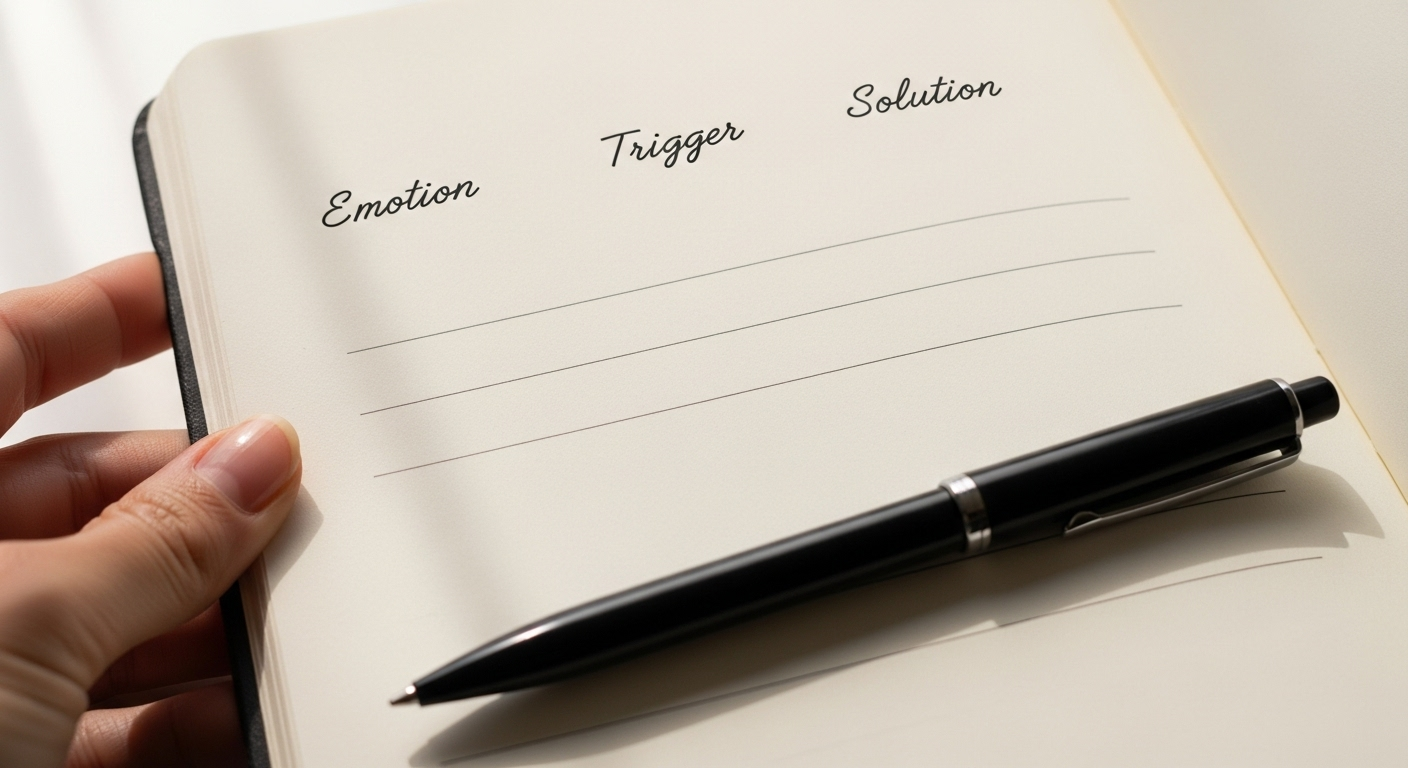Introduction to Anxiety Journaling
When I first started Anxiety Journaling, I realized just how much worry had taken over my life. I often felt overwhelmed, indecisive, and mentally exhausted. Even small tasks seemed daunting, and my thoughts constantly raced.
Starting a journal changed everything for me. By writing down my thoughts and feelings each day, I began to notice patterns I had never recognized. Anxiety Journaling helped me separate my emotions from reality, allowing me to see my worries more clearly.
Beyond just tracking thoughts, journaling became a safe space where I could process emotions without judgment. It became a practice of self-reflection and emotional release. Over time, even short entries helped reduce mental clutter and gave me a sense of calm. I realized that Anxiety Journaling is not just a writing exercise—it is a tool for transforming worry into actionable insights that I can use in everyday life.

How Anxiety Journaling Works
Understanding Your Thoughts
When I first tried writing my worries down, I didn’t know where to start. I learned that simply putting my thoughts on paper makes them more manageable. Seeing my worries in writing helped me analyze them objectively.
Each journal entry typically includes:
- What I am feeling
- Why I feel that way
- What might help me cope
Through this process, Anxiety Journaling allowed me to break down abstract worries into concrete thoughts that I could examine without feeling overwhelmed.
Recognizing Triggers
One of the first things I noticed through journaling was recurring triggers. For example, I realized that late-night emails or looming deadlines consistently increased my anxiety. By identifying these patterns, I started to anticipate stressful situations and respond more calmly.
Transforming Worries into Action for Anxiety Journaling
A major benefit I discovered is that journaling helps turn worry into actionable steps. Instead of dwelling on the problem, I break it down into manageable actions. For instance, if I worried about an upcoming presentation, I would outline preparation steps and create a small timeline. Taking action reduced my stress immediately.
Anxiety Journaling also allowed me to practice self-compassion. By acknowledging my fears in writing, I became less critical of myself and more understanding of my own emotions.
Benefits of Anxiety Journaling
Improved Self-Awareness
One of the first benefits I experienced was increased self-awareness. By journaling daily, I could clearly identify what triggered my stress. For example, I noticed that certain work tasks or interpersonal situations frequently caused anxiety.
Recognizing these patterns helped me plan proactive strategies, whether that meant adjusting my schedule or approaching a situation differently. Over time, I became more in tune with my emotional responses and better equipped to handle stress.
Emotional Release and Control
Journaling provides a safe outlet to express emotions that I might otherwise bottle up. Writing allows me to release tension and reflect on feelings without burdening others. After completing a session, I often feel lighter, calmer, and more focused.
Beyond emotional release, Anxiety Journaling gave me a sense of control. By identifying triggers and documenting possible solutions, I felt empowered to manage my anxiety rather than feeling overwhelmed by it.
Actionable Insights and Problem-Solving
One of the most powerful aspects of journaling is its ability to guide actionable insights. I no longer just sit with my worries—I use them to develop strategies. For example, when I felt anxious about an upcoming work deadline, I created a checklist, set priorities, and delegated tasks where possible. By converting worry into concrete steps, I not only reduced anxiety but also increased productivity.
Enhanced Mindfulness
Journaling naturally encourages mindfulness. As I write, I become more aware of my thoughts, body sensations, and emotional patterns. Anxiety Journaling taught me to notice early warning signs of stress and respond thoughtfully instead of reacting impulsively.
Building Long-Term Resilience
Over time, journaling revealed my progress. By reviewing past entries, I could see how I had successfully navigated challenges before. This awareness built resilience, helping me respond to new stressful situations calmly and with perspective. The more consistently I practiced, the stronger my ability to cope with anxiety became.
Techniques for Effective Anxiety Journaling
Structured Entries
To get the most benefit, I structure my journal entries. I typically divide each entry into sections for emotion, trigger, intensity, and solution. This structure helps me track patterns and reflect on my progress over time.
Guided Questions
I often use prompts to guide my writing. Some questions I find helpful include:
- “What am I worried about today?”
- “Is this worry based on facts or assumptions?”
- “What small step can I take to address this?”
Answering these questions helps me clarify my thoughts and avoid unproductive rumination.
Reviewing and Reflecting
Weekly reflection is a critical component of my journaling practice. Reviewing past entries allows me to identify recurring themes and assess what coping strategies worked. Anxiety Journaling becomes a proactive tool when I use it to learn from past experiences.
Using Prompts for Creativity
Sometimes I create prompts to reframe worries positively. For example, I might write, “What advice would I give a friend in this situation?” or “How can I view this challenge as an opportunity?” These exercises encourage creative problem-solving and help me cultivate a more positive mindset.
Digital vs. Paper Journals
I experiment with both digital and paper journals. Digital apps are convenient for on-the-go entries, while a paper journal feels more personal and reflective. Each format has its advantages, and I switch depending on my schedule and needs.
Common Mistakes and How to Avoid Them through Anxiety Journaling
Only Listing Feelings
Early on, I made the mistake of writing down emotions without analyzing them. While it provided temporary relief, it did not lead to insight. Now, I combine reflection and actionable steps to make my journaling effective.
Repeating Worries Without Solutions
Sometimes I would write the same worries repeatedly without seeking solutions. This pattern reinforced anxiety instead of alleviating it. I now pair every concern with a small, actionable step to address it.
Skipping Reflection
Skipping the review of past entries prevented me from recognizing patterns and learning from my experiences. Reflection is essential for turning journaling into a tool for transformation rather than just expression.
Unrealistic Expectations
I initially expected immediate results. Anxiety is complex, and insights develop gradually with consistent practice. Patience is key to making journaling a sustainable habit.
Real-Life Applications of Anxiety Journaling
At Work
Journaling helped me manage project deadlines, prepare for presentations, and improve professional communication. By writing down tasks and concerns, I prioritized effectively and avoided burnout.
At Home
I clarified my emotions before discussing personal issues with family or friends. Journaling allowed me to approach conversations calmly, reducing conflict and improving understanding.
Creativity and Hobbies
I noticed that anxiety often blocked my creative projects. Journaling helped me identify the fears holding me back. Once I outlined these concerns, I could strategize ways to move forward.
Daily Life Integration
I keep a small journal in my bag for quick entries. Short, five-minute sessions during breaks or commutes help me process thoughts and stay grounded throughout the day.
Travel and Transitions
During travel or major life transitions, journaling keeps my mind focused. Even brief reflections help calm nerves and maintain clarity during stressful situations.
Tips for Beginners in Anxiety Journaling
- Start Small: Even five minutes per day is effective.
- Be Honest: Write openly without censoring yourself.
- Use Prompts: Guided questions help generate insight.
- Reflect Weekly: Look for patterns and actionable steps.
- Celebrate Wins: Recording small victories reinforces progress.
- Stay Consistent: Daily practice maximizes results.
- Combine With Mindfulness: Breathing exercises enhance focus before journaling.
Research Insights in Anxiety Journaling
Studies show that journaling reduces stress and improves overall mood. Writing about emotions strengthens cognitive processing and self-awareness. Regular reflection fosters resilience and effective coping strategies. Integrating these findings validated my personal experience and reinforced the power of Anxiety Journaling.
Advanced Techniques for Anxiety Journaling
Tracking Progress
I pair journaling with a mood tracker. This helps visualize correlations between habits and emotional well-being. Seeing improvements over time boosts motivation and self-confidence.
Reframing Negative Thoughts
I reframe worries into actionable or positive statements. For instance, “I might fail this project” becomes “I will break it into manageable steps.” This technique reduces anxiety and fosters proactive problem-solving.
Combining With Therapy
If anxiety feels overwhelming, sharing journal insights with a therapist enhances treatment outcomes. Journaling complements therapy by providing concrete examples of triggers and coping strategies.
Conclusion on Anxiety Journaling
Through my personal journey, I discovered that Anxiety Journaling is transformative. It enhances self-awareness, reduces stress, and converts worry into actionable strategies.
Consistency, reflection, and honest writing maximize benefits. Incorporating Anxiety Journaling into daily life empowers me to feel focused, in control, and resilient. This practice nurtures mindfulness, emotional regulation, and long-term personal growth.
Ultimately, journaling is more than writing; it is a pathway to clarity, calm, and practical solutions that can improve every area of life.
read more : Overthinking Hack: 60-Second Mind Reset now
Watch youtube videos : Soojz | The Psychology Corner






